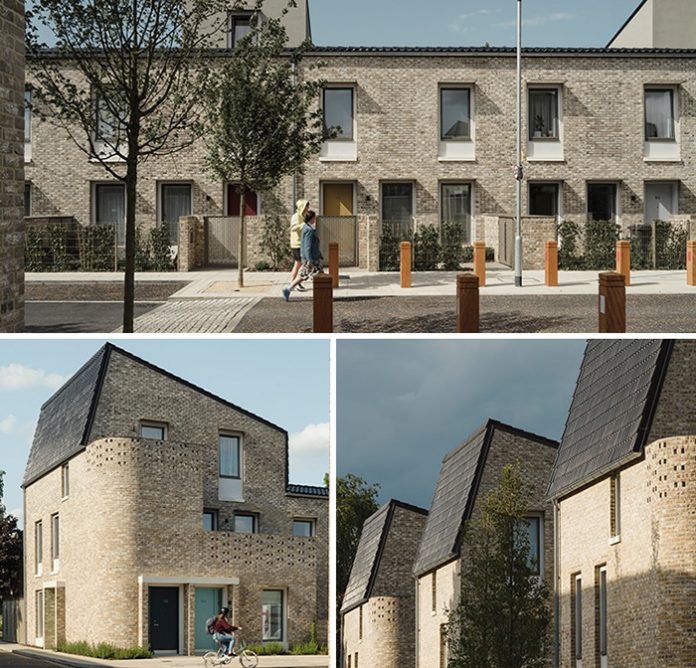The Royal Institute of British Architects (RIBA) has named Goldsmith Street in Norwich, designed by Mikhail Riches with Cathy Hawley, as the winner of the 2019 RIBA Stirling Prize
The annual RIBA Stirling Prize, presented since 1996, is awarded to the UK’s best new building. Goldsmith Street is comprised of almost 100 ultra low-energy homes for Norwich City Council.
In contrast to the higher-rise flats dominating the surrounding area, Goldsmith Street is arranged in seven terrace blocks, modelled on the Victorian streets of the nearby ‘Golden Triangle’ district.
The houses on Goldsmith Street
Rows of two-storey houses are bookended by three-storey flats, each with their own front door, generous lobby space for prams and bikes, and a private balcony.
The back gardens of the central terraces share a secure ‘ginnel’ (alleyway) for children to play together, and a wide landscaped walkway for communal gatherings runs perpendicularly through the middle of the estate.
Parking has been pushed to the outer edges of the development, ensuring that people own the streets, not their cars.
Environmental standards
Goldsmith Street meets rigorous ‘Passivhaus’ environmental standards – remarkable for a dense, mass housing development. It is a passive solar scheme, designed to minimise fuel bills for residents (annual energy costs are estimated to be 70% cheaper than for the average household).
To maximise solar gain, all homes face south and every wall is over 600mm thick, and the roofs are angled at 15 degrees to ensure each terrace does not block sunlight from homes in the street behind.
Even the smallest details have been meticulously considered: letterboxes are built into external porches, rather than the front doors, to reduce any possibility of draughts; and perforated aluminium ‘brise-soleils’ provide sunshades above the windows and doors.
Building materials
The palette of building materials references Norwich’s history, such as the glossy black roof pantiles – a nod to the city’s Dutch trading links – and the creamy clay bricks, similar to Victorian terraces nearby. To ensure the windows echoed Victorian proportions but also met ‘Passivhaus’ requirements, the architects developed a recessed feature, giving the impression of a much larger opening but limiting the amount of glass.
Bespoke steel mesh garden gates and brightly coloured front doors give each home a strong sense of individuality and ownership.
The 2019 RIBA Stirling Prize judges, chaired by Julia Barfield, said: “Goldsmith Street is a modest masterpiece. It is high-quality architecture in its purest most environmentally and socially-conscious form.
“This is proper social housing, over ten years in the making, delivered by an ambitious and thoughtful council. These desirable, spacious, low-energy properties should be the norm for all council housing.
“Over a quarter of the site is communal space – evidence of the generosity of the scheme. A secure alleyway connects neighbours at the bottom of their garden fences and a lushly-planted communal area runs through the estate, providing an inviting place for residents to gather and children to play, and fostering strong community engagement and social cohesion.
“Goldsmith Street is a ground-breaking project and an outstanding contribution to British architecture.”
Alan Jones, RIBA president, said: “Faced with a global climate emergency, the worst housing crisis for generations and crippling local authority cuts, Goldsmith Street is a beacon of hope. It is commended not just as a transformative social housing scheme and eco-development, but a pioneering exemplar for other local authorities to follow.”
David Mikhail, of Mikhail Riches, said: “Goldsmith Street’s success is testimony to the vision and leadership of Norwich City Council. We thank them for their commitment and support. They believe that council housing tenants deserve great design.
“It is not often we are appointed to work on a project so closely aligned with what we believe matters; buildings people love which are low impact. We hope other Local Authorities will be inspired to deliver beautiful homes for people who need them the most, and at an affordable price.”
Councillor Gail Harris, Norwich City Council’s cabinet member for social housing, commented: “This is an incredibly proud moment for Norwich, our strong history of building social housing and our ambitions to raise environmental standards.
“Winning this prestigious award shows that it is possible to build fantastic new council homes, despite the challenges posed by central government cuts and restrictions around Right to Buy receipts.
“We are so grateful to Mikhail Riches for sharing our vision for these homes and helping us to create a sustainable community for our residents.”
Goldsmith Street was chosen by the jury from the following outstanding shortlisted projects:
- Cork House, Berkshire by Matthew Barnett Howland with Dido Milne and Oliver Wilton
- London Bridge Station by Grimshaw
- Nevill Holt Opera, Leicestershire by Witherford Watson Mann Architects
- The Macallan Distillery and Visitor Experience, Moray by Rogers Stirk Harbour + Partners
- The Weston, Yorkshire Sculpture Park by Feilden Fowles Architects
The jury for the 2019 RIBA Stirling Prize was: Julia Barfield (chair); RIBA President, Alan Jones; 2018 RIBA Stirling Prize winner, Michael Jones, Foster + Partners; Lay Assessor, Kathy Gee MBE and Zac Monro, Principal at Zac Monro Architects. Architect Gary Clark was sustainability advisor.
John Alker, Director of Policy and Places at UKGBC, said: “Norwich City Council has shown incredible vision and leadership with Goldsmith Street and has set a very strong example for others to follow. This local authority has proved that by investing in great design, it is possible to create a development that reaps the rewards of a holistic approach that prioritises both the environment and the needs of the local community.
“Goldsmith Street demonstrates that social housing can and should be great quality and highly sustainable – there is clearly a strong business case for it.
“As more and more local authorities step up and declare a climate emergency, it is clear to many that the climate crisis requires a comprehensive response. This project shows that we can step up to the climate challenge and address it in a way that benefits everyone.”














